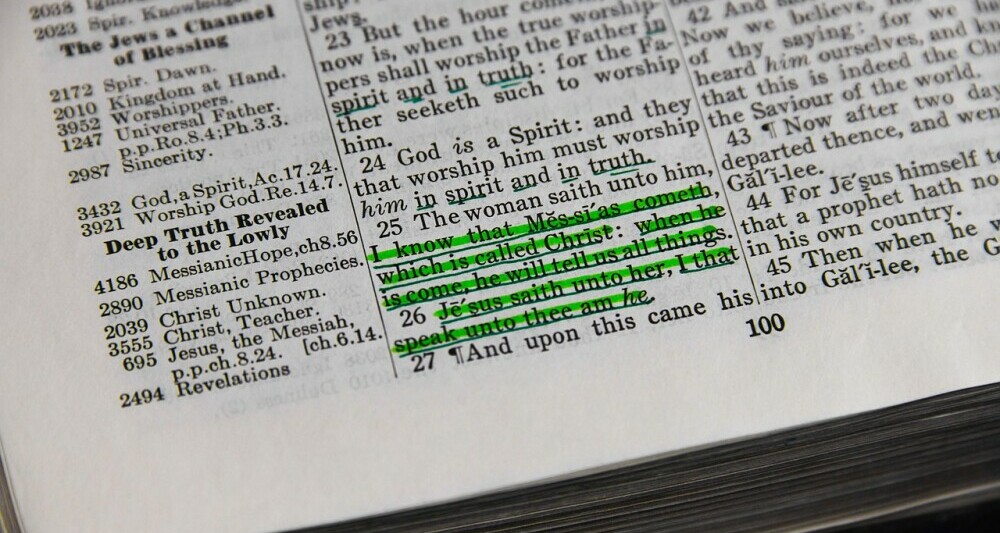5 Creative Ways To Study The Bible
So you’re interested in connecting with the Bible in a fresh and immersive way? I’m here to help you with an inspiring approach:
 (Image: Birmingham Museums Trust | unsplash)
(Image: Birmingham Museums Trust | unsplash)
Biblical art journaling
Imagine opening your journal to a blank page and letting the spirit move your hands to create artwork that embodies the verses you’ve just read. This isn’t just about making art; it’s about visualizing your faith and understanding of Scripture.
Let’s talk about how you can get started. First, you’ll need a journal or a sketchbook. Choose something that resonates with you, whether it’s lined, blank, or dotted. Don’t worry too much about perfection here; the key is to express what you feel, not to create a masterpiece. Gather some art supplies like pencils, markers, watercolors, or whatever else you like to create with. Just remember, there’s no right or wrong way to do this.
Your art can be as straightforward or symbolic as you want it to be. Use colors, images, and simple symbols to convey ideas. As you read a passage, think about the emotions it stirs within you, or the messages you find most compelling. Try summarizing these into visual representations that make sense to you. You’re going to discover that this type of study can open up a new level of connection with Scripture.
I really hope that your art journal becomes a vibrant, living record of your spiritual journey. It allows you to engage not just your analytical side but also your creativity and emotions, all while deepening your understanding of the Bible’s messages.
 (Image: Patrick Fore | unsplash)
(Image: Patrick Fore | unsplash)
The Melody of Scripture – Bible Verse Memorization
Memorizing Bible verses doesn’t have to feel like a chore. By setting them to a tune or transforming them into poetry, you’re weaving them into the fabric of your daily life in a way that’s both memorable and meaningful. I’m going to show you how a bit of rhythm or rhyme can make scripture stick.
Creating personal melodies gives a unique twist to memorization. Choose a verse that resonates with you, and think of a melody that matches the emotion or message. It’s okay if you’re not a composer; even a simple tune can do wonders. And guess what? This method taps into the brain’s auditory and musical areas, making memorization more natural.
Scriptural Poems
Let’s not overlook the power of poetry, which has been linked to worship and reflection throughout history. Writing your own scriptural poems can help you engage with the verses on a creative level. Focus on the themes that stand out to you, whether it’s grace, redemption, or perseverance, and let your pen flow.
Songs and Hymns
If you’re more into existing music, dive into the vast pool of songs and hymns inspired by the Bible. These can help you learn scripture while reinforcing the message through the artistry of others. In my opinion, it’s wonderful to connect with the broader community of believers through shared songs.
This approach goes beyond just learning words; it’s about embedding the values and teachings of the Bible into your very being. As you sing, you’re not just recalling verses; you’re celebrating your faith. And when that tune gets stuck in your head, it’s more than a catchy jingle—it’s a fragment of divine wisdom accompanying you throughout your day.
 (Image: Sincerely Media | unsplash)
(Image: Sincerely Media | unsplash)
Engaging with Scripture – Immersive Bible Study Techniques
Now that you’ve explored the harmonious blend between music or poetry and Scripture, let’s continue to bring the Bible to life. Implementing dramatic readings or reenactments transforms the text from pages into palpable experiences. By assigning roles and diving into the narratives, you’ll relate to the biblical characters and contexts in ways that mere reading doesn’t allow.
Organize a casual get-together with friends or a small group from your community, and select passages that lend themselves to dramatization. You don’t need Broadway-level production—just a few simple props or costumes and the willingness to embody a character. You may be surprised by the insights and conversations that emerge from these sessions.
For those who prefer reflection over action, Bible journaling prompts offer a structured approach to dig deeper into Scripture. Questions like ‘What emotions do I detect in this passage, and why might they be significant?’ or ‘How can I apply this teaching in a real-world scenario?’ propel you into a closer examination of your beliefs, assumptions, and life applications.
Finally, Scripture visualization and meditation invite you to slow down and immerse yourself in God’s Word. While reflecting on a passage, imagine being part of the story—witness events unfold and sense the atmosphere. This isn’t just about engaging your mind; it’s about allowing your emotions and senses to connect with the divine narrative.
You can always adjust your approach down the road, but I really hope that these methods enrich your Bible study routine and your spiritual journey. Embrace the discoveries, and remember that every step forward, no matter how small, is significant in your walk with faith. So, choose something that resonates with you, dive in, and let God’s Word transform you from the inside out.
Psalm 119:105. “Your word is a lamp for my feet, a light on my path.” This verse reminds us that the Bible is not just a book of words, but a guiding light that illuminates our journey and helps us navigate through life’s challenges.
PRAYER: May God’s Word inspire and guide you as you embark on this creative journey of deepening your connection with Scripture. Amen!





